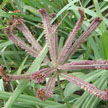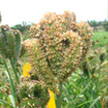Climate
Ragi is an important food crop next to rice, wheat and maize. Ragi is valued as staple food in South India. It is predominately grown as a dry land crop in the peninsular Indian states of Karnataka, Andhra Pradesh and Tamil Nadu.
Ragi is a crop of tropical and subtropical climate and can be grown successfully from sea level to an altitude of 2100 meters on hill slopes as well as in plains. It is very adaptable to higher elevations and is grown in the Himalaya up to 2,300 meters in elevation. It is a very hardy crop. It can be grown under rainfed as well as irrigated conditions. It grows best in moist climate. It is grown in areas with rainfall up to 100 cm. In regions of higher rainfall and under irrigation, it can also be grown as a transplanted crop. It is also raised as summer crop, and as Rabicrop in south India, but mainly as Kharifcrop in north India.
Climatic Factors
Latitude and Altitude
- Most extensive ragi growing areas are within 450N of the equator
- In India ragi is grown under widely varying conditions of altitude and climate
- Ragi cultivation in India extends from 8 to 35°N latitude and from sea level to as high as 3000 meters elevation. It grows well in altitudes of 1000- 2000m above the mean sea level
 Top of page
Top of page
Temperature
- Ragi is a crop of tropical and subtropical climate, requires a fairly high temperature, ranging from 20 to 40° C
- The optimum temperature 32° C during day time and 25° C during night time seems to be more favourable for the development and growth of ragi crop
- Crop yields are reduced at temperatures below 20oC. The crop possesses good drought tolerance but is highly sensitive to frost.
Growth Stages and Optimum temperature ranges
| Stage | Optimum temperature (°C) |
|---|---|
| Germination | 25 - 32 |
| Seedling emergence | 25 - 30 |
| Rooting | 25 - 28 |
| Leaf elongation | 31 |
| Tillering | 25 - 31 |
| Panicle initiation | 15 - 30 |
| Anthesis | 30 - 33 |
| Ripening | 20 - 25 |
 Top of page
Top of page
Sunshine
- Sunlight is very essential for the development and growth of the plants.
- The yield of ragi is influenced by the solar radiation particularly during the last 35 to 45 days of its ripening period.
- Bright sunshine with low temperature during ripening period of the crop helps in the development of in the grains.
- 300 cal /cm-2 /day is minimum required.
- Better yield is obtained when the Solar Radiation is 500-700 cal /cm-2 /day.
 Top of page
Top of page
Rainfall
- Rainfall has direct impact on deciding the ecosystem
- Ragi is suited for cultivation in areas with annual rainfall of 700-1200 mm.
- It does not tolerate heavy rainfall and requires a dry spell at the time of grain ripening
- Heavy downpour at anthesis and flowering leads to sterility
- If normal rainfall fails, yield will be reduced
 Top of page
Top of page
Relative Humidity
- Relative humidity is more during rainy days and dry weather prevails during non rainy days
- Relative humidity (RH) directly influences the water relations of plant and indirectly affects leaf growth, photosynthesis, pollination, occurrence of diseases and finally economic yield.
- The incidence of insect pests and diseases is high under high humidity conditions.
- High RH favours easy germination of fungal spores on plant leaves.
- Majority of pest and diseases are commonly seen during rainy season while aphids, scales, mealy bugs and mites are relatively more severe during summer.
- Blast disease of ragi is common in winter season.
 Top of page
Top of page
Wind
- Wind is normally unimportant factor in ragi production.
- A light wind is said to be beneficial as it stirs air and transports CO2 to the leaf canopy.
- Very strong winds do occur during cyclones and lead to severe damage.
- During pollination, strong wind may induce sterility and increase the number of abortive endosperms.
- Strong wind during flowering phase may not be conducive for rice crop.
- High wind speed during flowering may cause pollen dehydration and consequent spikelet sterility.




